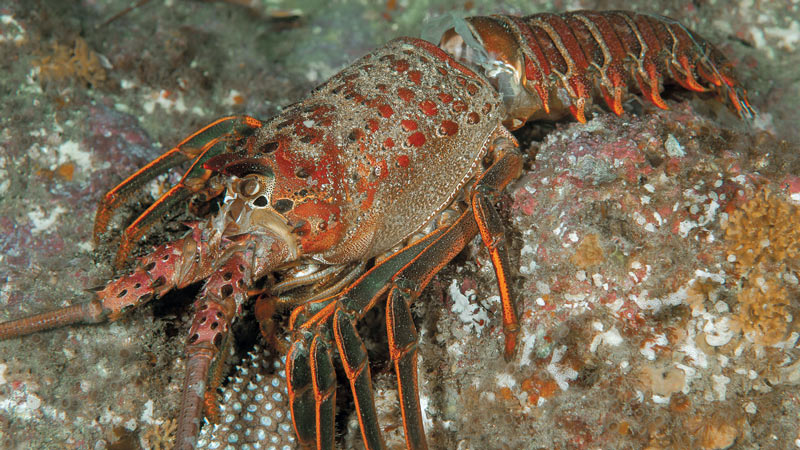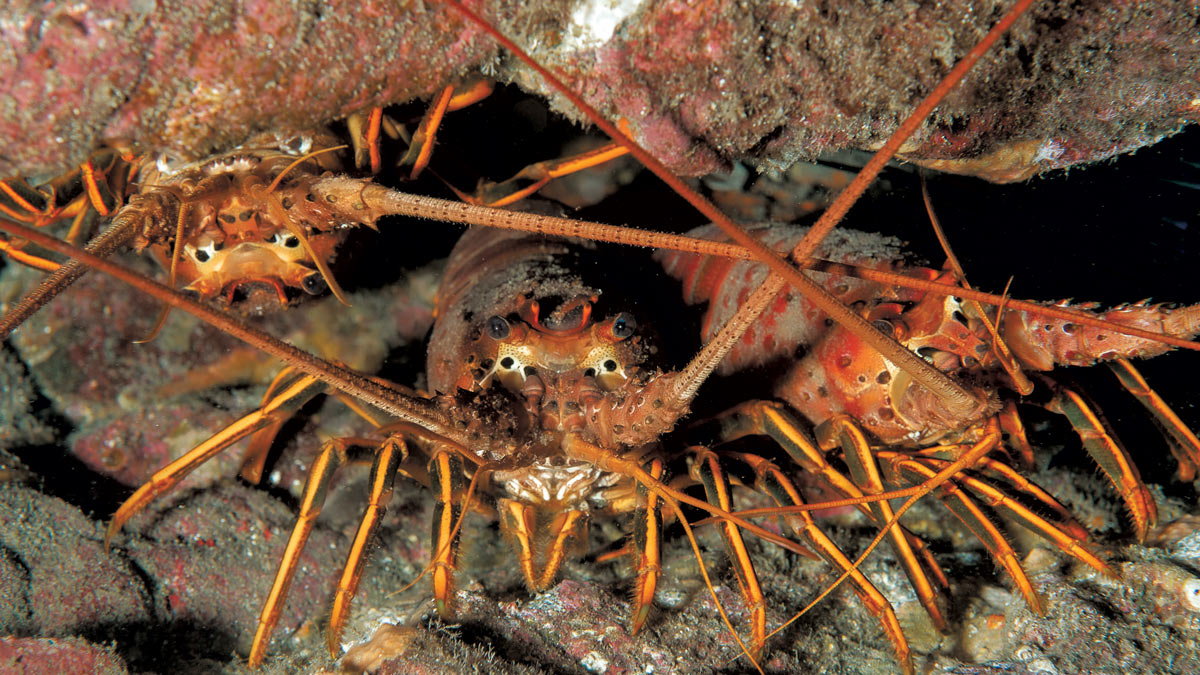In a crowd of divers, there are a handful of animals that when mentioned in conversation will cause everyone else to stop talking and start listening. Whale, shark, dolphin, and manta ray are a few of the words that command our attention. The word lobster often causes a similar response in some “bug hunting” California divers, especially in the fall and winter when California lobsters of legal size are fair game. A highly sought-after species that deserves our respect and protection, this crustacean leads a fascinating life.
DESCRIPTION
With the average length of a mature specimen being close to 12 inches, the California spiny lobster is one of the larger species of spiny lobsters. That said, these reef residents grow to a length of two feet and weigh as much as 26 pounds. As is the case with all spiny lobsters, the California spiny lobster has a pair of long, spine-covered antennae that are used in a whip-like manner for defense as well as two shorter, antennaelike looking appendages called antennules that are used for sensory perception. The segmented, hard, bump-covered exoskeleton is reddish brown with yellowish orange stripes running the length of their 10 legs.
Males and females can be distinguished from one another by noting the position of their two round genital openings known as gonopores. The openings are located at the bases of the third pair of legs (pereiopods) in females. In males, the openings are at the bases of the fifth pair of legs, those appendages that are farthest from the head and closest to the abdomen. Mature females possess a small claw on their fifth pair of legs. Females have feathery looking appendages called swimmerets (aka pleopods) underneath their tail. As their name suggests, swimmerets assist in swimming and for brooding eggs.
RANGE AND HABITAT OF CALIFORNIA SPINY LOBSTER
California spiny lobsters inhabit reefs from Point Arguello in Santa Barbara County, California southward along the entire length of Mexico’s Baja peninsula into the Sea of Cortez. There are some records of California spiny lobsters from Monterey Bay, but the water in that area is too cold to support a breeding population. Some specialists suspect that larval animals were carried into Monterey Bay by warm currents during El Niño years.
California spiny lobsters live in areas where the bottom is rocky and filled with crevices, ledges, cracks, and caves. These tasty crustaceans are sometimes found in tide pools and at other times, they venture as deep as 240 feet. Adults tend to prefer deeper areas while juveniles are often found from the surface to a depth of 15 feet in areas with rocky reef that is covered by surf grass.
Exactly where the best place to find lobsters of legal size is a hotly debated topic among California divers. At different times over the course of most years, legal-sized “bugs”, as they are often called, can be found at depths ranging from tide pools to reefs that are much too deep for sport divers to explore. As a rule, California spiny lobsters tend to move into shallower reef communities in spring and summer, while heading into deeper areas in fall and winter, but there are no absolutes. During daylight hours, California spiny lobsters are usually found in holes and crevices, and under ledges. At night, these omnivorous scavengers vacate their daytime hiding places to search for the snails, sand dollars, shellfish, and detritus that comprise much of their food.

The molt, or shed exoskeleton, of a California spiny lobster.
FUN FACTS ABOUT CALIFORNIA SPINY LOBSTERS
Despite their lack of claws, California spiny lobsters are well-protected. They use their hard shell, numerous body spines and whip-like antennae to thwart potential predators. When threatened, California spiny lobsters often retreat into the recesses of the reef. But when caught out in the open, they will often produce a loud noise by rubbing their antennae over the edge of their hard antennular plate to repel a predator or rely on their ability to move backwards at surprisingly fast speeds.
It is generally believed that some California spiny lobsters live at least 50 years, and perhaps as long as 100 years, in the wild. Reaching sexual maturity requires between three and six years for males and five to nine years for females. During a spawning season that extends from May through July, males deposit strings of sperm packets on the abdomen of females. When a female lays her eggs, she digs a hole in the sperm packets in order to release the sperm and fertilize the eggs. She carries the eggs in grape-like clusters on her swimmerets for about 10 weeks until they hatch. Larvae are planktonic for as long as eight months until they settle to the sea floor where they will spend the remainder of their lives.
In addition to being highly sought after by both commercial fishermen and sport divers, California spiny lobsters are preyed upon by California sheephead, giant sea bass, cabezon, moray eels, octopuses, sea otters, horn sharks, leopard sharks, and Pacific angelsharks.
PHYLUM: Arthropoda
SUBPHYLUM: Crustacea
CLASS: Malacostraca
ORDER: Decapoda
FAMILY: Palinuridae
GENUS AND SPECIES: Panulirus interruptus. The genus name Panulirus is derived from the Greek work palin for backwards and oura meaning tail. A California spiny lobster often rests with its tail folded under its abdomen, a position in which the tail can be said to be pointing backwards. The word interruptus comes from Latin meaning to break apart, a reference to the “interrupted” groves that run across the tail of a California spiny lobster.









